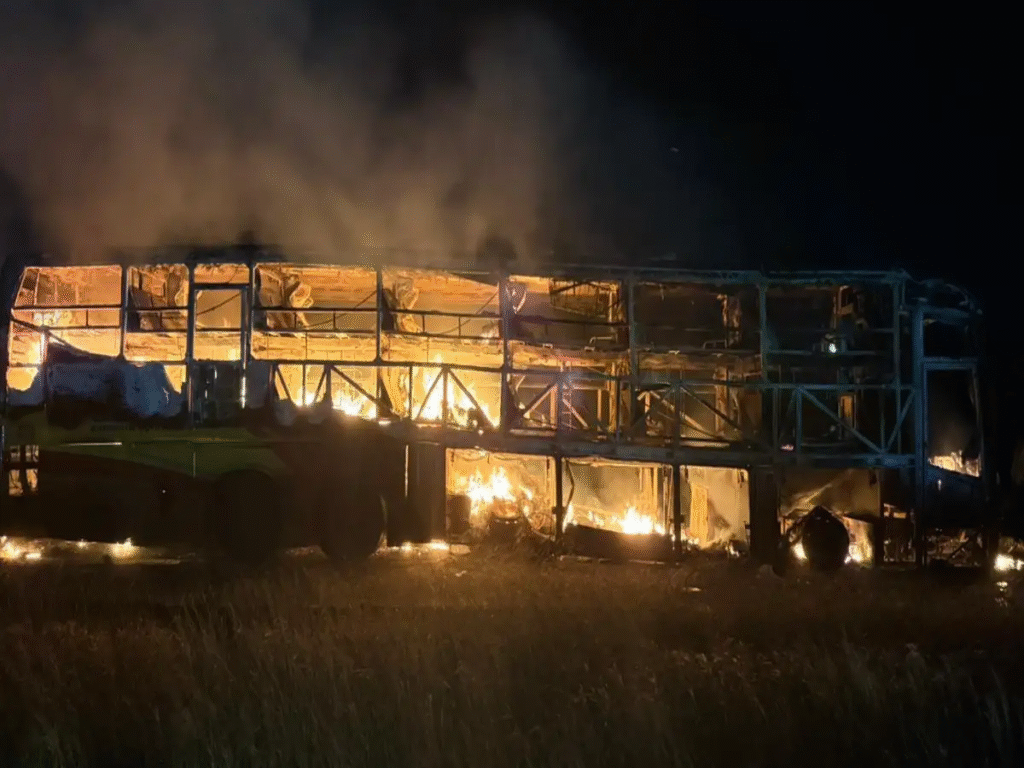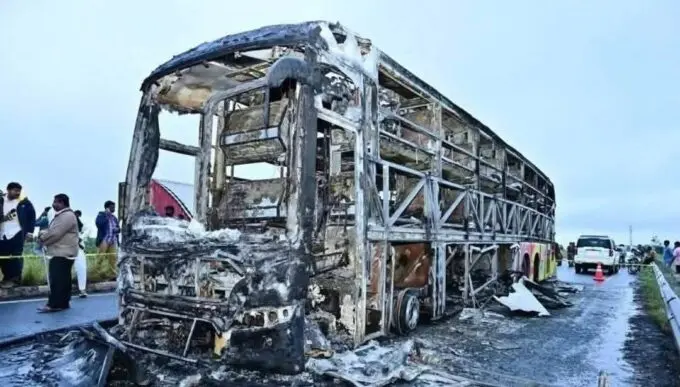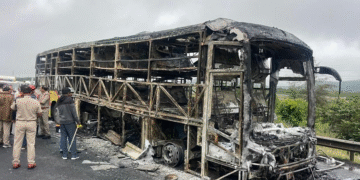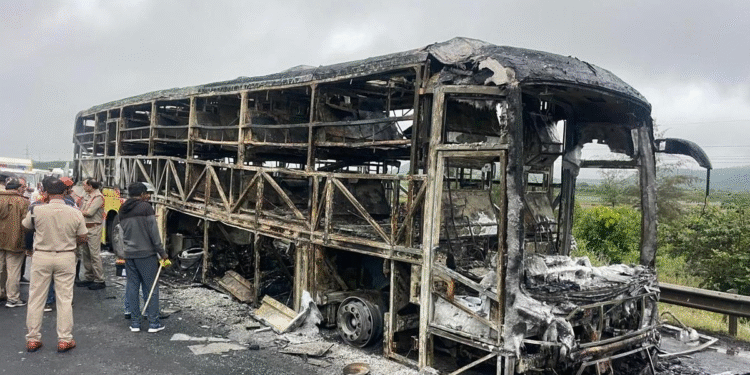Tragedy struck early morning on the Hyderabad-Bengaluru highway when a private bus carrying over 40 passengers collided with a two-wheeler and caught fire in Andhra Pradesh’s Kurnool district. At least 20 people were killed, many bodies charred beyond recognition, and the police have begun DNA collection to identify the victims
Kurnool, Andhra Pradesh – October 24, 2025
In a horrific road tragedy early Friday, a private sleeper bus travelling from Hyderabad to Bengaluru caught fire after colliding with a motorcycle near Chinnatekuru village in the Kurnool district of Andhra Pradesh. At least 20 people have been confirmed dead, with some reports putting the figure closer to 21, and several others injured and undergoing treatment.
What Happened
According to the preliminary investigation:
- The bus, reportedly a Volvo AC coach of a private operator (believed to be Kaveri Travels) carrying approximately 40–42 passengers, left Hyderabad in the small hours of the morning and was heading towards Bengaluru via National Highway 44.
- Around 3:30 am, as the vehicle passed near Chinnatekuru village, it collided with a two-wheeler (motorcycle) from behind. The motorcycle became trapped under the bus, dragging it along for some distance. Sparks from the collision and friction are believed to have ignited the fire, possibly near or at the bus’s fuel tank area.
- The fire engulfed the bus within minutes. Survivors say that many passengers were asleep at the time of the blaze and were unable to respond. Some passengers managed to break their way out of windows; others were trapped as the doors jammed and the cabin filled with smoke and flames.
- One police source stated that around 12 people escaped with minor injuries by breaking windows or emergency exits, but many others could not.

Casualties & Ongoing Rescue
The toll from the blaze remains uncertain, but district officials indicate that more than 20 passengers died. Many of the bodies were so badly charred that visual identification was not possible at the scene.
Emergency services responded, and injured passengers were rushed to Kurnool Government Hospital for treatment. Night-time rain and darkness reportedly added to the difficulty of rescue operations, as fire crews and police reached the site in the early hours.
DNA Collection & Identification Efforts
Because of the severity of burns and the state of many bodies, the local police have initiated DNA sampling and forensic procedures to identify the deceased. Relatives of missing persons are being asked to provide blood samples or other DNA matches to assist with the process. This step reflects the extent of the tragedy and the difficulty in identifying victims by sight alone.
Response from Government & Authorities
- N. Chandrababu Naidu, Chief Minister of Andhra Pradesh, who was abroad at the time, issued a statement expressing deep sorrow and directed that all possible assistance be given to injured persons and next of kin of the deceased.
- Police have registered a case under relevant sections of the Motor Vehicle Act, Indian Penal Code and fire-safety regulations. Investigations are focused on the bus operator’s compliance with safety norms, driver vigilance, vehicle maintenance records, passenger manifest accuracy, and the exact mechanics of how the fire began and spread.
- Traffic on NH-44 near the accident site was diverted for hours as rescue, firefighting and forensic teams worked through the early morning.
Safety Lapses & Preliminary Findings
Investigations have pointed to several preliminary issues:
- The bus’s door on one side reportedly jammed, preventing escape from that exit and forcing some passengers to break windows.
- Combustible interior materials inside the bus, combined with the sudden ignition, allowed the fire to spread extremely fast, trapping many.
- The collision with the motorcycle apparently triggered the spark/ignition, but how the motorcycle came to be behind the bus (overtaking, speeding, etc.) is still being probed.
- Because many victims were asleep, their reaction time was critically limited; this is a common factor in early-morning coach fire tragedies.
- Whether the bus had fully functioning fire extinguishers, emergency exits, acoustic alarms or daily safety checks is under scrutiny. Survivors report there was little warning and no time.

Human Stories & Impact
The loss is sudden and deep — passengers from Hyderabad, Bengaluru and along the route included young professionals, families returning home, children and elderly. Relatives arriving at the hospital and incident site faced distressing scenes: bodies charred beyond recognition, waiting in the dark for identification. Relief camps and counselling support have been sounded by the state government.
Some survivors recounted terror: “I woke to billowing smoke and flames in the aisle; I had to break the window and jump out,” said one passenger who was treated for burns. Others were less fortunate, as the fire swept through before alarms or full escape could happen.
Wider Implications & Insights
- This incident once again spotlights the safety vulnerabilities of overnight private bus travel in India, especially on major highways where travel by night is common but oversight can be lax.
- The speed with which fire engulfed the bus raises questions about bus construction standards, fire-resistant materials, fuel-tank placement and access to emergency exits.
- Regulatory oversight of private bus operators (licensing, inspections, passenger manifest accuracy, adherence to rest-periods for drivers) remains a key concern.
- For families of victims, the inability to identify loved ones visually and the subsequent need for DNA testing compounds the trauma and delays closure.
- For the highways authority and traffic police, ensuring safe corridors, defined accident-response protocols, and rapid rescue capability is critical in early-morning accidents when traffic is sparse and response slower.
What’s Next in the Investigation
- Detailed forensic analysis of the burned vehicle — engine, fuel tank area, ignition source, interior material burn-patterns — will be conducted to ascertain cause and responsibility.
- The bus owner/operator will be questioned, vehicle maintenance logs examined, driver’s licensure, journey timing, and route authorization checked.
- Passengers list (manifest) will be cross-checked with survivors, missing reports and identified bodies to ensure all are accounted for and next-of-kin informed.
- Victim compensation: The state government is expected to announce ex-gratia payments for the dead and injured. Meanwhile, insurance claims from the bus operator and possible penal action are under consideration.
- Safety audit of similar overnight bus services on the Hyderabad-Bengaluru route and across AP/Telangana/Karnataka is likely to be initiated to prevent recurrence.
In Summary
The bus fire near Chinnatekuru village on the Hyderabad-Bengaluru highway is a chilling reminder of how quickly a routine long-distance bus journey can become a fatal disaster. With over 20 lives lost and many more survivors scarred physically and emotionally, the tragedy raises urgent questions about vehicular safety, emergency preparedness, operator responsibility and highway oversight.
As DNA identification continues and victims’ families await closure, the incident calls for systemic reform — from bus construction norms, fire-safety equipment, driver training, to regulatory enforcement of private bus operations. For now, the focus remains on rescue, relief, investigation and, ultimately, accountability.
Also Read : Piyush Pandey, the voice of Indian advertising, dies at 70















 Categories
Categories









